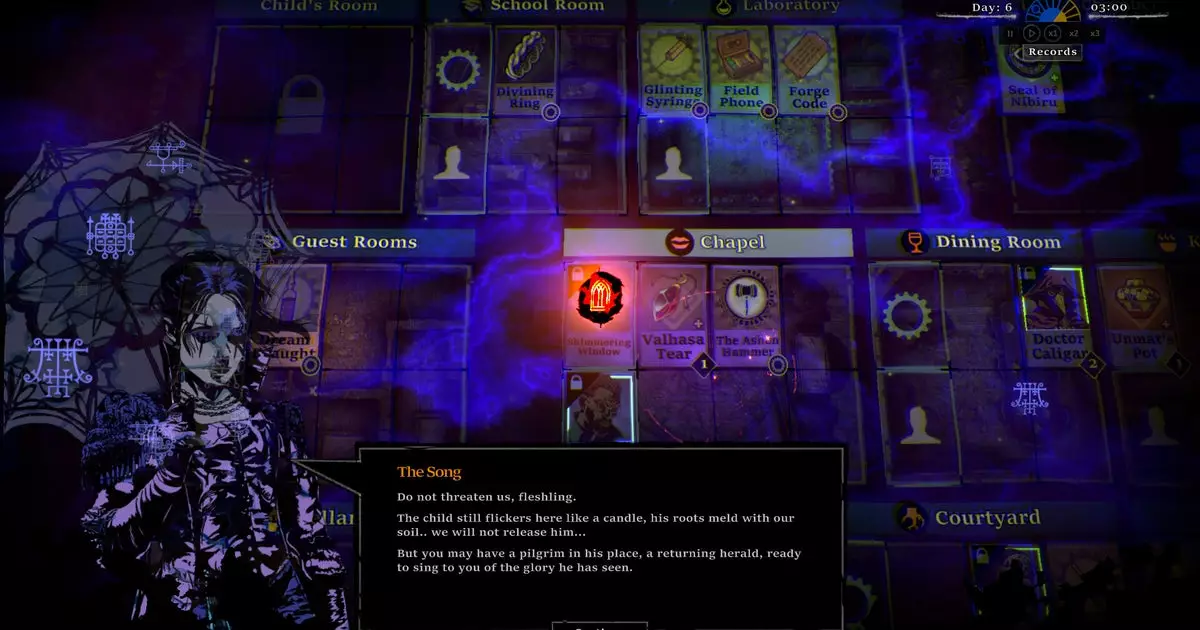In the realm of gaming, few experiences can captivate players consistently as the atmospheric elements of a well-crafted environment. “The Horror At Highrook,” a haunted house RPG, excels in this aspect, drawing players into a world rich with visual allure and ambiance. As you engage with the demo, you will notice the seamless transition of colors that shifts from the dull grays of midday to the rich hues of dusk, ultimately settling into the eerie light of moonlit lavender. This delicate manipulation of color not only sets the emotional tone but also instills a sense of wonder and dread that is essential for a horror game.
While the beauty of the game invites players to lose themselves in its aesthetics, there’s an underlying urgency that continually demands attention. Players cannot afford to simply admire the scenery; neglecting the tasks at hand leads to dire consequences. Characters can suffer from hunger, fatigue, and escalating madness if left idle. This blend of visual charm and gameplay pressure creates a unique tension that encourages strategic engagement.
In “The Horror At Highrook,” resource management plays a critical role. Players must keep their character’s physical and mental well-being in check while navigating the complexities of the mansion. As you move characters around to fulfill various roles—cooking meals or deciphering clues from dusty tomes—you quickly realize this isn’t merely a game of exploration; it’s a relentless balancing act. With the constant threat of starvation or insanity looming over your party, the stakes are palpable.
In addition to managing immediate character needs, players are also tasked with uncovering the mysteries that obscure the mansion, particularly the chilling disappearance of the Ackeron family. Clues scattered throughout the game hint at the secrets buried within the sealed chapel and the ominous underground tunnels. This layering of tasks adds depth, transforming the game into an intricate puzzle where every decision can lead to either salvation or doom.
“The Horror At Highrook” invites comparisons to beloved titles such as “Darkest Dungeon” and even “Cluedo,” yet it carves out its distinct identity by blending gothic storytelling elements with strategic gameplay mechanics. The character interactions and distinct traits add another layer to the narrative, with cards representing artifacts, visions, and character qualities. Such mechanics create a tapestry of storylines that players can weave into their gameplay, offering opportunities for both personal and collaborative exploration of the game’s central enigma.
The description of characters, such as the plague doctor Caligula, lends a poetic quality to the gameplay, showcasing how their powers can be amplified by special cards. This thoughtful integration of character development with gameplay fosters an organic growth that immerses players even deeper into the dark world of Highrook.
An interesting layer to consider is the historical context surrounding the game’s creation. The developer, Tom Betts, has roots in the indie gaming scene, and while the gameplay of “The Horror At Highrook” may evoke nostalgia akin to “Cultist Simulator,” it’s essential to approach the experience with fresh eyes. This duality creates a unique tension, a haunted past as players engage with new narratives while finding echoes of those they have previously enjoyed.
Despite the engaging qualities of the characters and stories, there are noticeable imperfections. For example, some characters’ accents and personalities feel underdeveloped, leading to questions about their origins and motivations. This inconsistency can cause players to momentarily disengage, but these rough edges may well smooth out as the game evolves.
“The Horror At Highrook” stands out in the crowded landscape of role-playing games due to its stunning visuals, intricate resource management, and a deep narrative interwoven with gothic elements. While the game grapples with the shadows of its predecessors, it undeniably offers a fresh perspective filled with excitement and mystery. The blend of aesthetic beauty and strategic depth invites players on a haunting journey that challenges not only their gaming skills but also their capacity to engage with the story on multiple levels. Whether you choose to dive into its immersive world now or wait until its full release, one thing remains certain: the experience promises to be unforgettable.

